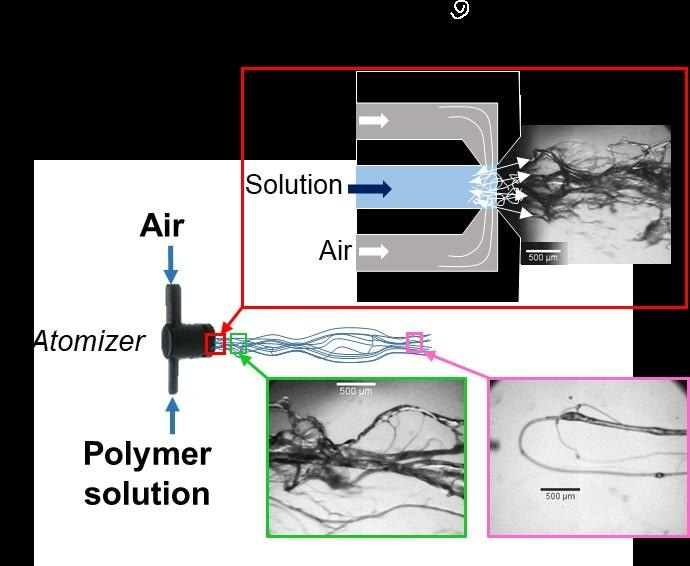Apr 30 2019
A research team at the Higher Technical School of Engineering of the University of Seville has yielded fibers and filaments from highly viscous liquids using technology that is generally employed to create drops.
 This is a description of the production of PEG fibers with the Flow Blurring atomizers used in the study. (Image caption: Universidad de Sevilla)
This is a description of the production of PEG fibers with the Flow Blurring atomizers used in the study. (Image caption: Universidad de Sevilla)
Using their study, they have identified the conditions required for the creation of filaments which are below 50 µm thick (as a reference, the thickness of a strand of human hair is around 150 µm).
The experts have found out that there is an instant at which a polymer in liquid state—particularly one that has been developed from polyethylene glycol, which is extensively used in industry—exhibits greater elasticity that, rather than getting separated and forming drops, the liquid suffers a stretching, which leads to the formation of filaments. The formation process for these filaments is influenced by parameters such as the molecular weight of the polymer and its concentration on the liquid, and also the pressure that is used in the device.
Flow Blurring technology was used for this research. Professor Alfonso Gañán Calvo at the University of Seville developed this technology and it is a highly efficient technique for atomizing liquid, known as nebulization.
In this technology, a current of air is used to break up a liquid and create drops just like the nebulization systems that are used to refresh terraces in summer. Flow Blurring devices are extremely efficient as they channel the energy that the gas current has for the generation of drops by strongly blending with the liquid, preventing losses due to other mechanisms.
Furthermore, it has been demonstrated that pneumatic Flow Blurring devices create about 50 times more surface area for each liter of nebulized liquid. This produces drops that are about 50 times smaller when compared to those produced by other atomizers. This is achieved since Flow Blurring nebulizers concentrate the energy to such an extent that they can atomize substances as viscous as paint, or as in this case, high-concentration polymer solutions.
Using a high-speed camera, capable of recording a million images a second, we can observe that under certain conditions of use with Flow Blurring devices, polyethylene glycol solutions (and solutions of other polymers) do not form drops, but fragment into fine ‘threads’ that, when carried by an air current stretch out as they leave the atomizer. The diameter of these filaments is reduced, partly because polyethylene glycol is a shear thinning viscoelastic liquid. This means that when it stretches, it becomes less viscous, so that it becomes ever easier to stretch.
Luis Modesto López, Study Author and Teacher, University of Seville.
Polymer Fibers at 3 kg/hour
Polymers are macromolecules that exist in every part of modern life. Cork, silk, starch, and cellulose are some of the most common natural polymers. Synthetic polymers are usually available as coverings that offer definite functionality to materials, for instance, making them resistant to corrosion or humidity.
“In today’s world, there is great scientific and technological interest in the use of polymer fibers to make: frameworks for the design of artificial biocompatible materials, surfaces with antibacterial properties, materials for targeted drug delivery, protective textile materials that are capable of blocking some specific substances, or as reinforcement material. However, the manufacturing on an industrial scale of these materials means making them in great quantities. It is from this that our study takes on particular relevance as it provides a basis for developing a new process that will make it possible to produce filaments and polymer fibers at elevated levels, of the order of 3kg/hour using a simple nebulizer, while with the most common techniques in current use, they are produced at the rate of 1g/hour,” states the researcher.
This technology could also find application in the field of 3D printing, given that what this technology does is managing a polymer. Furthermore, the work has a broad range of applications in the field of Material Science, as it paves the way for the production of a wide range of compound materials.